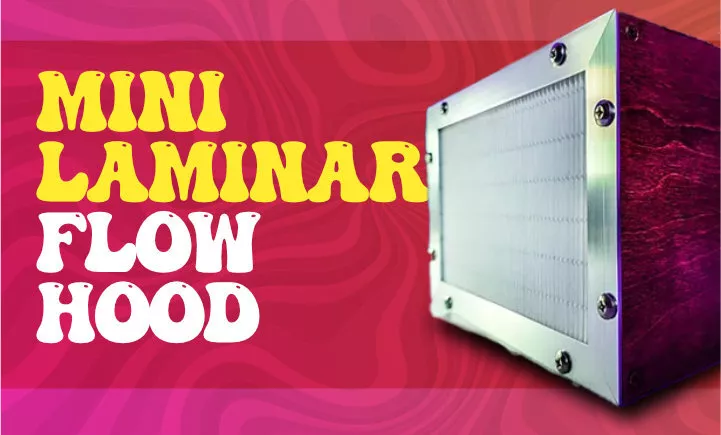In mushroom cultivation, we understand that maintaining sterile conditions is paramount. Whether you’re a seasoned mycologist or a hobbyist taking your first steps in this fascinating field, one tool you’ll find indispensable is the laminar flow hood.
We’ve seen firsthand how these devices can significantly reduce contamination risks and increase overall yields.
That’s why we’ve put together this comprehensive buyer’s guide for 2023 to help you navigate the myriad options available on the market.
We’ll discuss what a laminar flow hood is, its crucial role in mushroom cultivation, and critical factors to consider when purchasing one.
What is a Laminar Flow Hood?
When it comes to mushroom cultivation, one tool that’s often overlooked but incredibly vital is the laminar flow hood.
These devices, which come in vertical or horizontal models, offer a sterile environment for growing our favorite fungi. They protect against contaminants and ensure optimal growth conditions.
We’ll explore different types of laminar flow hoods to help you make an informed choice based on your particular mushroom cultivation needs.
Types of Laminar Flow Hoods
In mushroom cultivation, laminar flow hoods play a vital role in maintaining sterile and particle-free working conditions.
The different types, such as the horizontal laminar flow hood, vertical laminar flow hood, mini laminar flow hood, and small laminar flow hood, each have their unique specifications tailored to specific cultivation needs.
Here, we’ll delve into the different types of laminar flow hoods available in the market, their unique features, and their suitability for specific applications.
Horizontal Laminar Flow Hood
You’ll love the efficiency of a horizontal laminar flow hood, especially if you’re serious about mushroom cultivation. The design of this type of hood is such that it pushes clean, laminar air flow from the back to the front across your workbench.
This process creates a sterile environment in your work area, which is crucial for preventing contamination during inoculation and other delicate tasks in mushroom cultivation. The horizontal laminar flow hood is equipped with a HEPA filter which captures 99.97% of particulates 0.3 microns or larger, offering superior filtration and ensuring that only pure, filtered air reaches your mycelium cultures.
It’s no exaggeration to say that these hoods are an impressive piece of equipment for any cultivator keen on maintaining a clean bench throughout their operations!
Vertical Laminar Flow Hood
In contrast to the horizontal model, a vertical laminar flow hood pushes air from top to bottom, creating an equally sterile environment for your sensitive mycelium cultures. This type of laminar flow hood is particularly useful in mycology as it provides a reliable cleanroom atmosphere for working with delicate mushroom species.
Here are some key features of a vertical laminar flow hood:
- The powerful blower system ensures efficient and smooth airflow.
- A prefilter captures larger particulate matter, extending the primary filter’s life.
- High-efficiency particulate air (HEPA) filters provide excellent sterilization by removing 99.97% of particles as small as 0.3 micrometers.
- Its unique design allows gravity to assist in the particle removal process.
Investing in a good quality vertical laminar flow hood can significantly improve your success rates in mushroom cultivation by reducing contamination risks and ensuring optimal growth conditions for your cultures.

Mini Laminar Flow Hood
For those with limited space or a smaller scale operation, a mini laminar flow hood might be the perfect solution. These compact units, also called laminar flow clean benches, provide filtered air to ensure your mushroom cultivation area remains free from contaminants.
The fan filter unit in these hoods pushes clean air through a HEPA filter, effectively creating an environment where the air is constantly moving and reducing the chance of unwanted particles settling on your cultures. These devices can come as either vertical air flow models or horizontal laminar flow cabinets, depending on your specific needs and available space.
With this type of air flow hood at hand, you’ll have a controlled, clean environment—a laminar flow workstation—ensuring that your mushroom cultivars thrive without any risk of contamination.
Small Laminar Flow Hood
When it comes to maintaining a contaminant-free environment in your smaller-scale lab or growing space, there’s nothing quite like a small laminar flow hood. These fume hoods can easily be placed on your work surface for flexible workspace optimization, and some models are even freestanding if benchtop space is limited.
With the power of recirculation technology, they effectively filter out contaminants and provide a steady stream of clean air across your work area – typically offering around 100 cubic feet per minute (cfm) of airflow. Plus, many come with built-in LED lights to ensure adequate illumination while working with your mushroom cultures.
So whether you’re an amateur mycologist or running a small commercial operation, investing in a small laminar flow hood could significantly enhance your cultivation process.
Guide in Purchasing a Laminar Flow Hood
As we delve into the task of buying a laminar flow hood, it’s crucial to consider various factors such as size, air flow velocity, and filter efficiency.
We’ll also take you through prominent brands and models that have earned their stripes in mushroom cultivation.
Furthermore, we’ll give you an idea about pricing ranges and reliable places to purchase your equipment to get the best value for your investment.
Factors to Consider
You’ll feel a sense of satisfaction knowing you’ve chosen the perfect flow hood for your mushroom cultivation, but it’s essential to consider several factors before making your final decision.
One crucial aspect is the material of the hood, where stainless steel is highly recommended due to its durability and resistance to corrosion.
Your work environment also plays a vital role; make sure there’s enough space for the unit and that it can accommodate the activities you perform, such as PCR or cell culture preparations.
Moreover, consider if your processes require an ULPA (Ultra Low Penetration Air) filter, which can trap 99.999% of airborne contamination – an indispensable feature when working with sensitive cultures.
Next, consider whether the flow hood has either an FFU (Fan Filter Unit) or a removable filter system. An FFU has built-in fans that push air through filters and maintain a steady airflow in your workspace, dramatically reducing airborne contamination risks.
On the other hand, removable filters offer ease of maintenance and replacement – quite beneficial in prolonging equipment life span.
Last but not least: always aim for devices that provide solid performance while ensuring user comfort during long hours of work.
These considerations will guide you in selecting not just any flow hood but one that truly meets your unique mushroom cultivation needs.

Popular Brands and Models
Having examined the key factors to consider when choosing a flow hood for mushroom cultivation, let’s now delve into some of the top brands and models available in 2023. As you’ll soon realize, not all biosafety cabinets are created equal.
Some units are designed with mushroom cultivators specifically in mind, boasting features that enhance the growth and development of your fungi.
- ISO – ISO is renowned for their Class II Biological Safety Cabinets which are often used in tissue culture and other sensitive biological applications. These cabinets have been designed with polypropylene construction to resist corrosion from chemicals commonly used in mushroom cultivation, such as agar or other substrates.
- Labconco – Labconco offers a variety of biosafety cabinets suitable for mushroom cultivation, including their popular Purifier Logic+ Series. This series has models equipped with HEPA-filtered laminar airflow systems and built-in centrifuges that help ensure an aseptic environment for growing mushrooms.
- Thermo Fisher Scientific – Known for its high-quality laboratory equipment, Thermo Fisher Scientific also produces Class II Biosafety Cabinets under the brand name Herasafe KS Series. These units provide optimal protection for both product and the user during mushroom propagation activities.
Remember, while these brands offer excellent options, it’s crucial to choose a flow hood that suits your specific needs, size requirements, budget constraints, and degree of sterility needed.
Pricing and Where to Buy
When it comes to cost and sourcing your ideal flow hood, there’s quite a range to consider. The price can vary dramatically depending on the brand, model, and size of the unit you’re after.
Some of the top-end models can set you back several thousand dollars, but these are typically acrylic-built for increased durability and have additional features like built-in HEPA filters. On the other hand, more budget-friendly options may start as low as a few hundred dollars but may require additional purchases, such as separate HEPA filters or accessories.
While looking for where to buy your desired flow hood, opting for reliable suppliers that offer quality products is essential. You’ll find a variety of options both online and in physical stores specializing in mushroom cultivation or lab equipment.
Some manufacturers directly sell their products through their websites – this could also be a great place to grab some extras like syringes for inoculating your substrate.
Always remember, though: buying cheaper doesn’t always mean saving money in the long run; invest wisely in equipment that will last and deliver optimal results consistently.
Final Thoughts
In the end, it’s like standing in a lush forest teeming with mushrooms, and your perfect flow hood makes all the difference in cultivating a healthy and abundant harvest. A reliable flow hood is a game-changer; it not only ensures minimal contamination but also provides an ideal environment for mushroom growth. It’s an investment that pays off hugely by offering control over cultivation conditions and significantly increasing yield.
Remember, when it comes to mushroom cultivation, precise environmental control is everything. Finding the right balance of humidity, temperature, light exposure, and clean airflow is crucial – all achievable through a top-notch flow hood. Your chosen device should work efficiently while ensuring you’re not battling constant contamination issues. After all, each successful harvest begins with sterile conditions and ends with bountiful yields of delectable fungi.

